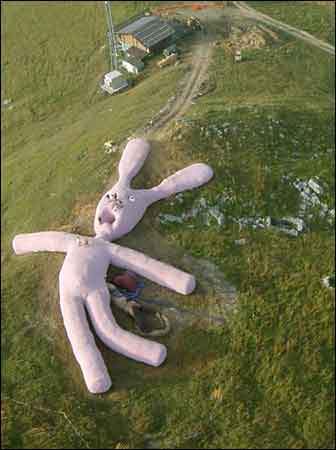
One of the original teddy bears, donated by the Michtom family and on display at National Museum of American History. Photo: Smithsonian
Teachers: Download this page as a PDF!
Some people call them stuffed animals. The toy industry says “plush toys.”
Others say Beanie Babies, Teddy Bears, Webkinz or Build-a-Bears. Whichever you prefer, everybody seems to love stuffed animals. How much do you know about them? Let’s explore!
1. Why are they called Teddy Bears? Visit http://bit.ly/T5zmpa – the Smithsonian’s blog, to learn how the “teddy bear” came to be. It was created by Morris and Rose Michtom, New York City candy shop owners, and part time stuffed animal makers. When they heard about President Theodore “Teddy” Roosevelt’s bear hunt, and his refusal to shoot a wounded bear, they sewed together a stuffed animal and gave it to the President. They went on to start their own toy company, the Ideal Novelty and Toy company, to sell their ‘teddy bears.’
2. T/F. Are there beans in a Beanie Baby? False. At http://www.madehow.com/Volume-5/Bean-Bag-Plush-Toy.html you can learn how a Beanie Baby is made from start to finish. (They use small plastic pellets, called poly beads.)
3.What’s the stuff inside a stuffed animal? At Beary Cheap http://www.bearycheap.com you can see some of the materials that professional stuffed animal makers use. They say that the right filling helps you get that “take me home” feel. Most modern stuffed animals use materials such as, poly beads (inside a beanie baby), plastic pellets (also called poly beads) and polyester fill. Older stuffed animals use cotton batting, cotton balls, newspaper, pebbles, or even rice.
4. How big is the world’s largest stuffed animal? Visit http://bit.ly/VDWVGN and you can see a giant stuffed animal on a mountain in Italy that is 200 feet long. It was made by a group of artists, called Gelitin, in 2008. It is so big, that it can be seen from Google Earth. The giant bunny took five years to build and it is made of soft, waterproof, materials and stuffed with straw.
5. Can I put a stuffed animal in the washing mashine? At the Dollar Stretcher you can find all sorts of tips on cleaning stuffed animal. For general cleaning, try baby wipes, or a damp cloth to spot clean the animals fur. Or, you can sprinkle a little baking soda on your animal, leave it for about 20 minutes, then, brush it off. Remember to brush your animal with a soft bristle brush to avoid damaging the fur. Some animals can even be washed in the washing machine (as long as it’s on the delicate or gentle cycle).
5. Is my stuffed animal worth any money? Here’s how you find out. First, check the tag. The tag can tell you who made your stuffed animal. The tag may also have the date your stuffed animal was made. Next, visit the manufacturers website to find out more details about your stuffed animal. Then, look at the condition of your stuffed animal. Is it like new or worn? Finally, check sites like eBay, http://www.ebay.com/, or Doll Values http://www.dollvalues.com where you can learn a lot about similarly priced toys. Did you know one Steiff teddy Girl sold in a Christies auction for $171,600.00. http://www.bornrich.com/entry/worlds-expensive-teddy-bears.
———————————————————————————————————————————————— LittleClickers.com (this page and the associated web site) is sponsored by Computer Explorers. Neither Children’s Technology Review (publisher of LittleClickers) or Computer Explorers has any vested interest in any of the sites listed on this page. Librarians and teachers are permitted to copy this page for non-profit use. To report a bad link, use this form, or contact us. Copyright 2018, Children's Technology Review.
SIDEBAR
Attributes of a Quality Stuffed Animal Not all plush toys are created the same. Here are some attributes of quality:
- Non-allergenic materials.
- Solid stitching that can survive.
- Weighted with poly-beads.
- Look at the eyes and the nose. These are very important for making the animal look real.
- Washable
- Meaningful. Might resemble a former pet or something of significance.


